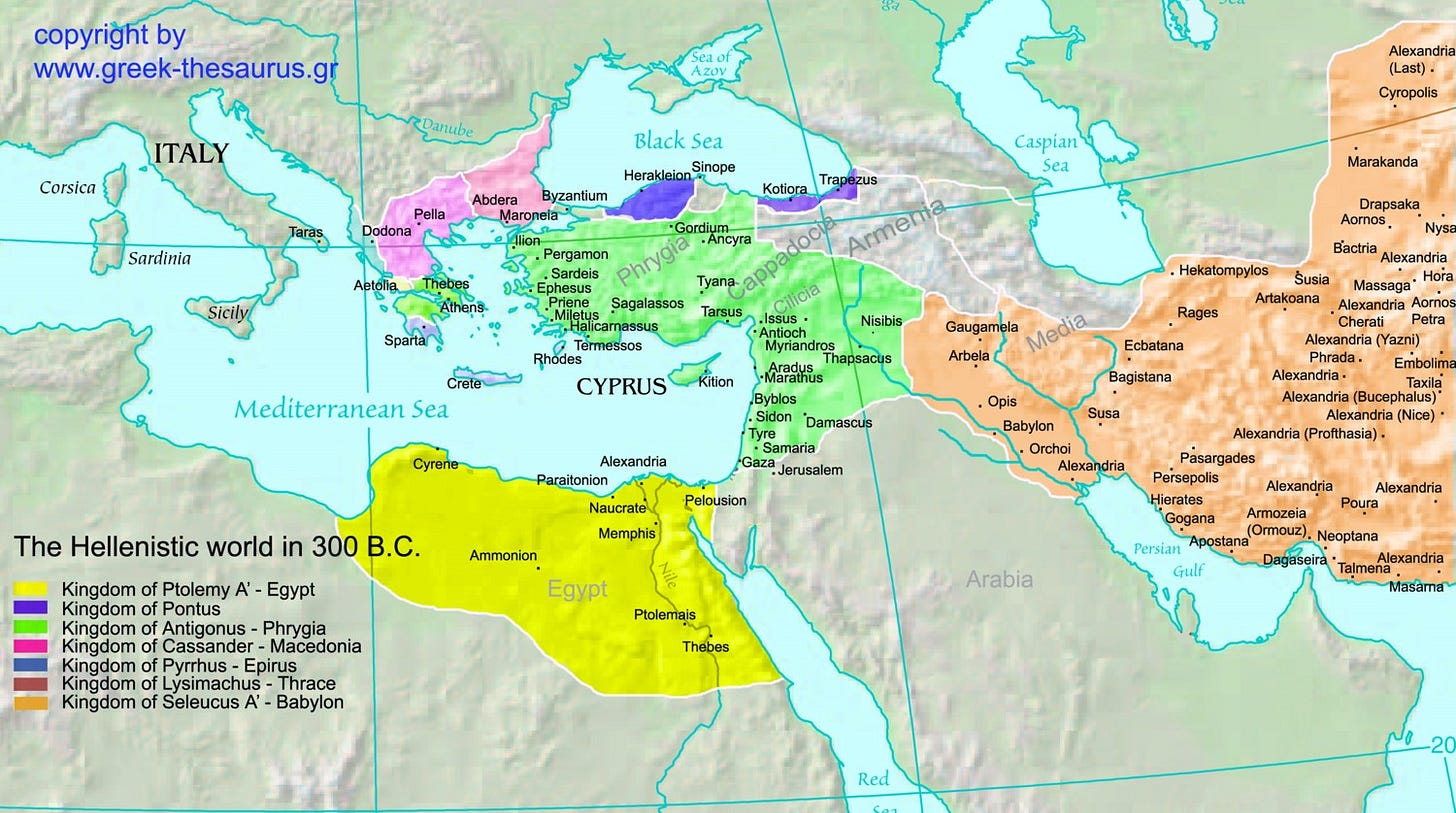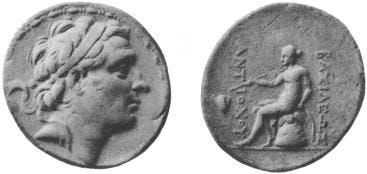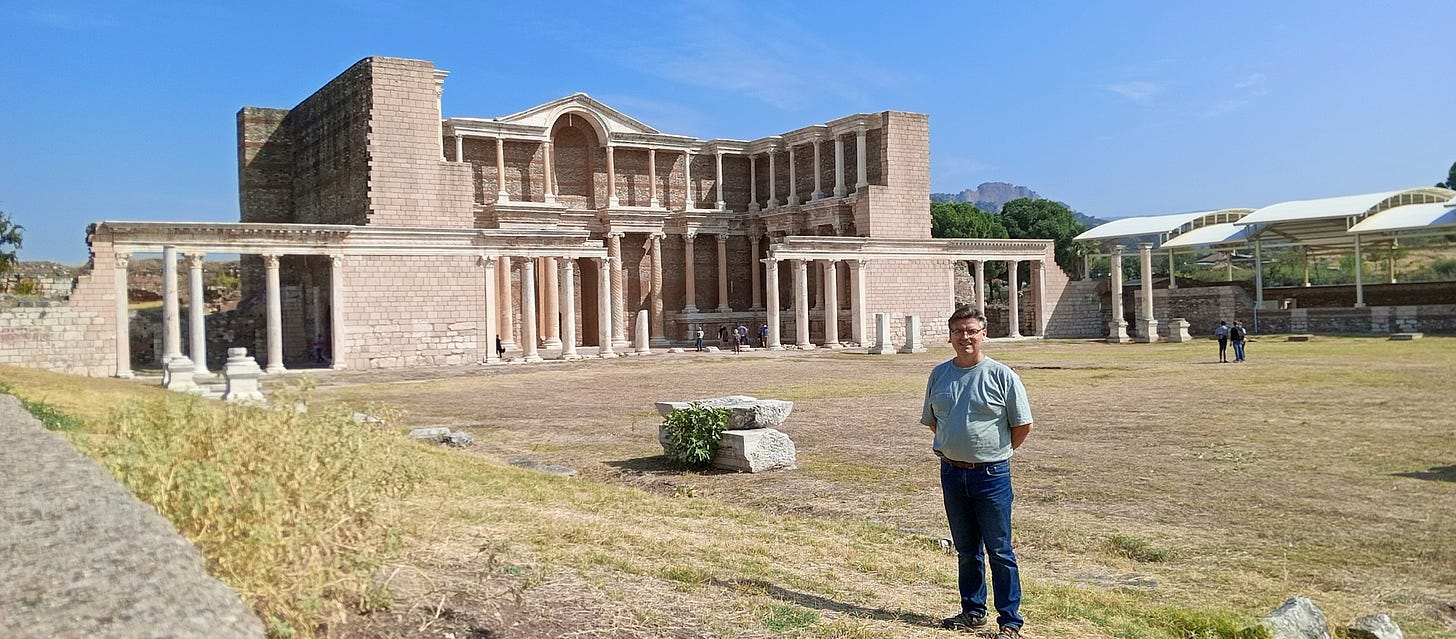Walking with the Greats in Sardis: Antiochus
Sardis is the city in Turkey where the pathways of the great conquerors of history converge. Antiochus (241-187) came close to matching Alexander's conquests, but a greater power was rising westward.
The Turkish village of Sart lies one kilometer from the highway that links Izmir with Ankara. It has one mosque, a gas station, and a handful of restaurants to serve the tourists that drop in to tour the ruins of a Roman city east of town.
Across the road from the ancient city, a mesa — a flat-topped Hill with cliffs on all sides— overlooks the way eastward. Tour busses don’t stop there. The only way to the top is a steep hiking trail with steep dropoffs. Yet this high place—known as an acropolis—is where four great conquerors all stood, whose tracks I have recounted in previous posts:
Gyges, the bodyguard who redeemed the honor of Queen Nyssia by murdering her husband and founding a dynasty of Lydian kings (687 BCE).
Cyrus, the Persian who defeated the world’s richest king and founded the Persian Empire (547 BCE)
Alexander, young king of Macedon, who raced to Sardis after his first victory over Persian armies at the Granicus River (334 BCE)
Today’s “great” is a ruler I hadn’t planned to include in this series until I ran across him in my research of Alexander and the Hellenistic Era (323-32 BCE) that followed his conquest. The more I learned about him, the more fascinated I became with an era that history books often overlook — between Alexander’s conquests and the Rise of Rome and the conquests of Julis Caesar (323 to 32 BCE).
In Alexander’s Wake
While Alexander was as great a conqueror as Cyrus, the empire he left behind — in the hands of his 4-year-old son — was unstable, violent, and dangerous. The era inaugurated by his defeat of the Persian Empire (559 to 331 BCE) is called the Hellenistic Era because of the flourishing of culture across western Asia. And while Greek culture spread throughout Asia, leaving an indelible mark, the age must have been very difficult for the people living in it.
It was an age of warlords and ever-changing borders. Vast armies marched here and there, from Olympus to the Oxus, from the Aegean to the Arabian seas. There was no “Macedonian Empire” per se. Instead an array of huge kingdoms — all ruled by Macedonians — struggled for supremacy.
Soon after Alexander died on 10 June 323, efforts by his family to hold onto the empire collapsed. Instead it was divided among four generals:
Cassander, who took Alexander’s original realm of Macedonia & northern Greece;
Antiochus, who ruled Anatolia and Syria;
Seleucus, who took Persia and Babylonia; and
Ptolemy, who took Egypt

The kingdoms didn’t stay within these borders. The final quarter of the 4th Century BCE was consumed by the wars of the Diadochi (successors), valiant attempts by the four generals—the most ambitious of whom was Antigonus — to recapture and rule the whole realm that Alexander had conquered. Unfortunately, Antigonus — who commissioned the city of Antioch as the capitol of his realm — had territory in the very middle of the other ambitious Diadochi: Ptolemy lay to the south in Egypt, Lysimachus ruled Thrace (the peninsula between the Black and Aegean seas) and Macedonia, and Seleucus, the satrap of Babylonia, had seized Antigonus’ eastern territories.
In the climactic Battle of Ipsus in 301 BCE, Antigonus was killed. His son, Demetrius forced to flee to Europe. Seleucus played a key role in the battle. As part of an alliance he had formed with Chandragupta, ruler of India, which bordered his eastern realms, Seleucus had received 500 war elephants. In exchange, Seleucus had given his daughter, Helene, in marriage. Facing Antigonus, who had 75 elephants on his side, Seleucus’ elephantine superiority turned the tide.
(Lysimachus took western Anatolia from Antigonus, the area around Sardis and Smyrna. He left his mark on Ephesus, moving the site of the city from the hill along which the present-day town of Selcuk lies to the site where the ancient city lies. There is much about him in the Ephesus Museum, and his huge mausoleum lies near Belevi, about 15 miles east of Selcuk.)
In 281 BCE, Seleucus defeated his erstwhile ally Lysimachus in battle, stretching his empire from Persia all the way to the Aegean Sea. Seleucus was assassinated (by a former ally, no less) as he was preparing an invasion of Europe, leading to more wars among his heirs — honestly, as difficult as this time must have been for common people, the lifespans of princes & princesses were tragically short.
The Rise of Antioches III
After Seleucus’s death, the empire he left to his heirs went into gradual decline. Initially the threat was not from the other diadochi: Egypt was stable under the Ptolemies, and constant upheaval in Greece & Macedonia kept their rulers busy. Instead, provinces within the empire rebelled under the leading of their Macedonian overlords and gained independence.
It’s interesting to look at these independence movements, just to get a feel for the breadth of the Seleucid Empire.

First the Celts invaded from western Europe, crossing the Bosphorus and laying waste to central Anatolia. They would not be the last Germanic tribe to invade. They eventually settled, and the region gained the name “Galatia,” from the Roman term for the Celts, “Gauls.”
Then the Greek governor of Bactria, Diodotus, declared independence in 255 BCE. This furthest reach of Alexander’s conquests — Present-day Afghanistan — lay securely between the Hindu-Kush mountain range and the Oxus river.
Another province of Persis, homeland of the Persian people just north of the Persian Gulf, declared independence.
Another Persian satrap, Andragoras, declared his realm of Parthia — on the northern border between present-day Iran and Turkemenistan — independent. This breakaway kingdom would eventually be overrun by Asiatic tribes, but it would leave its name to the Parthian Empire, which became a major obstacle to Rome in later centuries.
Bithynia, a region along the Black Sea coast of Anatolia, and Cappadochia, central Anatolia, north of Syria also gained autonomy. And the city-state of Pergamum, just 70 km north of Sardis, also grew in power.
That’s the realm that Antiochus III inherited when he took the throne at the tender age of 19 in 223 BCE. How he became “the great” instead of yet another of the diaochi to meet a premature, violent end, is the story that will lead us back to Sardis.
How Antiochus became “the Great”
Antiochus stumbled out of the gate. He had been saddled with a venal, back-stabbing counselor named Hermeas, who encouraged the young ruler to attack southern Syria and take the region known today as the “Holy Land” from the Ptolemies of Egypt.
Meanwhile, in the lands Antiochus already controlled, more rebellions sprang up to exploit the weakness of the young king. Media (present-day northwestern Iran) rebelled. And Antiochus’ cousin Achaeus took the region of Sardis as his own domain.
For three consecutive years, Antiochus remained south of his empire, fighting against Egypt. In 217, the Battle of Rafah (Gaza) crushed Antiochus’ invasion and sent him home defeated. At rock bottom, his position precarious, Antiochus poisoned Hermeas. And the next spring he began an anabasis that would end in greatness.
The word, anabasis, combines two Greek words: ana means “upward,” and basis comes from the verb, “to march.” With his dreams of Syrian conquest in tatters, he set out to reconquer the territories that had, one by one, gained autonomy from the Seleucid Empire. In this endeavor, Antiochus wasn’t just successful. He was great.
Antiochus set out for Sardis first, to rein in his rebellious cousin, Achaeus. A swift victory sent the traitor scurrying to the mountaintop citadel that overlooked the city in 215. In all history, only Cyrus the Great had ever stormed it successfully. Achaeus held out for two years, praying for relief from one of Antiochus’ many enemies.
Unable to scale the steep cliffs of the acropolis with his army, Antiochus resorted to treachery. A Cretan, hired by Ptolemy to help Achaeus escape the citadel, instead turned the usurper over to Antiochus, effectively doubling the ransom he received in the process. Sardis would fall a few days later without a fight.
Next Antiochus moved along the southern coast of the Black Sea, re-conquering Armenia in the process. In 209 he set out to restore his eastern provinces: first Parthia, then Bactria, where he negotiated a capitulation and gave the defeated king his daughter’s hand in marriage in an effort to preserve Greek domination in that distant land. He then moved south into India, where he obtained more war elephants in tribute from the king there. By 205, he had returned from his “upward march” a conqueror. This was the date when he began to be called the great.
For the first time since Antigonus, it seemed that one leader might reconquer all of Alexander’s domains. Antiochus moved again against Egypt and successfully drove the border back into Africa and occupying Lebanon and Judea.
How Antioches Lost the Title
On the border with Egypt, basking in the glow of his greatest victory, Antiochus received a message from a city-state far to the west: Rome. During his anabasis, Rome had been fighting a war of its own: the Second Punic War against Carthage. Like Antiochus, Rome had prevailed. These two powerful entities — one an empire, the other still a republic — were on a collision course.
The Romans’ message said, “Go no further.” Egypt was the breadbasket of Rome, and the city would accept no foreign domination of its key supplier. Satisfied with his gains in the Levant, Antiochus withdrew and turned his eyes toward Greece, whose city states were calling for him to support them against Roman encroachment. To help with these challenges, Antiochus brought to his court a notorious adviser: Hannibal Barca — yes, that Hannibal of Carthage, who had invaded Italy with his own war elephants and terrorized Rome.
Let’s pause to consider what Antiochus might have thought of Rome. He ruled western Asia, from India to the Aegean Sea. He was incredibly wealthy, and his vast army included Parthian archers and Indian war elephants. And though Rome had defeated a formidable power in Carthage, its territories were smaller and poorer than those of Antiochus.
That may be why, when he arrived in Greece to confront Rome, he came with only 10,000 men. And he marched southward at a leisurely pace. When he did meet the Roman army in 192 at Thermopylae — the very same pass that 300 Spartans had held against the Persians 190 years earlier. Despite initial success, Antiochus’s forces fell to the dogged, Roman army of 18,000.
Antiochus escaped. The Romans pursued him, helped by their allies from the city-state of Pergamum and the island of Rhodes. They met again near the city of Magnesia ad Sipylum (the modern Turkish city of Manisa) and — again — Rome and its allies prevailed. This site, lies just 15 km from Sardis.
In the Treaty of Apamea that followed, Antiochus ceded all lands west of the Taurus mountains, which stretch from Cilicia in a great eastern arc to the Caucasus where present-day Turkey, Georgia, and Armenia all meet. He also gave up his remaining war elephants, scuttled his navy, and promised Rome 15,000 talents of gold.
The defeat had a significant impact on Sardis. When Cyrus the Great had conquered the citadel in 547, he had made it the western point on the Royal Road. Now the road from Sardis to Susa was severed near its midpoint in the Taurus Mountains. The two cities would never belong to the same empire again.
The news of Antiochus’ defeat in the west gave his eastern provinces new impetus to rebel. Antiochus died two years later near fighting in Persia, the second effort of his reign to subjugate this region.
And Judea, the prize that he fought four wars against the Ptolemies of Egypt to obtain? It rebelled under his son, Antiochus IV Epiphanes (161 BCE), who had tried to Hellenize the temple in Jerusalem and convert it to a Temple to Zeus. It enjoyed a brief span of autonomy within the Seleucid Empire until 63, when Rome intervened in a succession dispute and added the territory to its realm.

Rome was still a republic in 189 BCE, unable to manage far-flung lands, but strong enough to makes its will felt anywhere in the Mediterranean Basin. It would split its winnings with its allies, Pergamum and Rhodes, who would dominate western Anatolia for the next 100 years. Sardis, Bithynia, Armenia, and Cappadochia — kingdoms Anciochus had re-conquered in his rise to greatness — all slipped from his grasp.

Did Antiochuse deserve the title “great”? From 205 to 190 BCE he conquered a vast swathe of land. But his armies fell to the Romans at the height of his power, and he is counted today among the defeated, not among the conquerors of antiquity.
I think that Antonis Chaliakopoulos puts it best.
Antiochus lived at a time when the Seleucid Empire was a shadow of its former self. The dynasty’s founder, Seleucus I, ruled over a kingdom that had one leg in India and the other in Thrace. But almost six decades later, the empire was in disarray. Antiochus III reclaimed a great part of the empire and forged a series of alliances with powerful kingdoms. For a brief moment, he even challenged Roman rule, but in the end, he was not capable of defeating the Romans.
Roman Sardis
Most visitors to Sardis visit the ruins of the Roman city. Archaeologists have restored the two-story facade of a bathhouse, which serves as a backdrop for a lush, green gymnasium complex.
Next to the gymnasium likes a huge synagogue, testifying to the presence of Jews in Sardis since 547 BCE, a generation after the Babylonians captured Jerusalsm.
Beyond the gymnasium lies the royal road, the trunk of the route whose other end was Susa in Persia. Columns lined the road as it ran through Sardis in Roman times, and the bases of several broad, ceremonial gates can also be seen.
With Pergamum — and later Rome — in control, Sardis entered seven centuries of peace and prosperity. The Christians of the First Century established a church here, identified by St. John in the opening chapter of the Book of Revelation. The only church to be found among the ruins today is a late-Roman structure on the site of the Temple of Artemis. Its footprint is 1/50th of the breadth of the huge synagogue.




